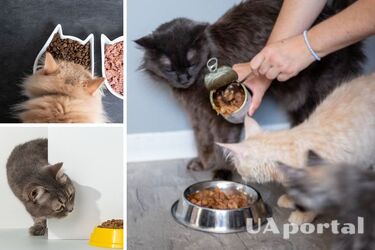Do cats need dry food and what is its daily intake: what do veterinarians say?

Many cat owners try to diversify their furry friends' diets by offering them both dry and wet food. Choosing between these two types of food can be difficult because each has its characteristics.
Mixed feeding, which combines wet and dry food, can be a great solution that will allow your cat to get all the nutrients it needs and stay healthy, according to the specialized publication josera.com.
Advantages and disadvantages of wet and dry food:
Wet food:
- High moisture content (60-85%), which is beneficial for urinary tract health.
- Pleasant taste and aroma, which makes it more attractive to cats.
- Easy to digest.
- Enriches the cat's diet with water.
- Less concentrated, so the cat eats more of it.
- It spoils faster.
- Can lead to tartar formation.
Dry food:
- High concentration of nutrients.
- It is stored for a long time.
- Helps to clean teeth and maintain oral hygiene.
- Easy to use.
- Low moisture content, which can lead to urinary tract problems.
- Less attractive to cats due to low moisture content.
- Can be difficult to digest.
Mixed food for cats
Mixed feeding combines the benefits of wet and dry foods, allowing your cat to get everything it needs. Here are some tips for mixed feeding:
The ratio of wet to dry food: 2/3 wet food and 1/3 dry food is a general rule of thumb. The amount may vary depending on your cat's age, weight, activity level, and needs.
How to feed dry food to cats and how much dry food a cat should eat
Dry food is a convenient and balanced food option for cats. It contains all the essential nutrients, vitamins, and minerals your cat needs to be healthy.
Here are some tips for feeding dry food to your cat:
- Choose a quality food. Look for food that contains a high percentage of protein (at least 30%) and a low percentage of carbohydrates. It is also important that the food does not contain artificial colors, flavors, or preservatives.
- Follow the instructions on the food packaging. The packaging usually indicates the recommended daily allowance of food for your cat. This amount may vary depending on your cat's age, weight, activity level, and health.
- Feed your cat 2-3 times a day. Adult cats can eat 2 times a day, and kittens can eat 3 times a day.
- Keep a bowl of water available at all times. Dry food contains little moisture, so your cat must always have access to fresh water.
- Monitor your cat's weight and overall health. If your cat is eating the recommended daily amount of food but is losing or gaining weight, you should contact your veterinarian.
How much dry food should a cat eat?
The amount of dry food your cat should eat depends on several factors, such as:
- Age: Kittens need more food per unit of weight than adult cats.
- Weight: Heavier cats need more food than lighter cats.
- Activity level: Active Cats need more food than cats that are sedentary.
- Health condition: Cats with certain medical conditions may require a special diet.
Here are general guidelines for the daily allowance of dry cat food:
Kittens (up to 6 months): 30-40 g of food per 1 kg of weight.
Adult cats (6-10 years old): 30-40 g of food per 1 kg of weight.
Senior cats (10 years and older): 25-30 g of food per 1 kg of weight.
It is important to remember that these are only general recommendations. It is best to consult your veterinarian to determine the optimal daily allowance of dry food for your cat.
If you want to get the latest news about the war and events in Ukraine, subscribe toour Telegram channel!
